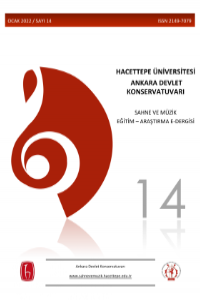SEICENTO VE İTALYAN BAROK MÜZİĞİ
Bu çalışmada İtalya’da Seicento dönemi ve reformu ışığında İtalyan Barok müziği incelenmiştir. İtalya; Barok stilin doğduğu, sanat, mimari ve müzik alanında yeni bir dönem ve anlayışın baş gösterdiği akımın beşiği olarak kabul edilmektedir. Katolik Kilisesi’nin Protestanlığın doğuşuna karşı varlığını ve birliğini korumak üzere aldığı önlemler çerçevesinde gelişen reformlar, sanat alanında özgürleşmeye giden yolun kapılarını aralar. Kilisenin büyüklüğünü, muhteşemliğini ve öğretisini anlatmak üzere destek gören sanat, İtalya’da yüksek değerde bir üretim dönemine girer. Opera’nın doğuşu, yeni formlar, besteleme çeşitleri, icra stilleri, geliştirilen enstrümanların bütün bu reformlara katkısı, yerel okulların ve kilisenin de etkisi ile yeni bir akım ve sanat anlayışı oluşur. İki yüzyıla yaklaşan bu dönemde modern müziğin temelleri atılır, baş yapıtlar üretilir. Bu kapsamda dönem bestecileri, armoninin geliştirilmesi, kompozisyondaki yenilikler ve yorumculukta ustalaşmanın birbirine olan büyük katkısı ile dönemin en spesifik özelliklerini oluşturan formları ve sanat türlerini geliştirmişlerdir. Bu çalışmanın oluşturulmasında, sanat alanındaki dönüşümü değerlendirebilmek için pek çok besteci ve eseri incelenmiş, Barok dönem müzik teorisi ile ilgili kaynaklara başvurulmuş, dönemde ve dönemi hazırlayan süreçte yer alan siyasi olaylar hakkında yazılan makaleler araştırılmıştır. Bu çalışmanın amacı Barok dönemin doğuşundaki Seicento dönemine ve İtalyan Barok müziğine ışık tutmaktır.
Anahtar Kelimeler:
Seicento, İtalyan Barok Müziği, Barok Dönem
In this study, Italian Baroque music was examined in the light of The Seicento period and its reform in Italy. Italy; that is accepted as the cradle of this movement, where baroque style was born and a new era and understanding of art, architecture and music have emerged. Reforms take place within the framework of the measures taken by the Catholic Church to protect its existence and unity against the birth of Protestantism, open a new door to the liberation in art. Art; supported to express greatness, magnificence and teachings of the church, enters a high-value production era in Italy. By the birth of the opera, new forms, composition types, performance styles, the contribution of the developed instruments to all these reforms, with the influence of regional schools and the church, a new movement and understanding of art is formed. During this period of nearly two centuries, the foundations of modern music laid and masterpieces were created. The composers of the period developed forms and art types that constitute the most specific features of the era, with the great contribution to the improvement of harmony, innovations in composition and the mastery of interpretation, in this context. In order to method in this study, many of the composers and their works were practiced, sources related to the theory of Baroque music were examined and articles containing the political events and the process that prepared the era were researched in order to evaluate the transformation in the field of art. The aim of this study is to shed light on The Italian Baroque music and The Seicento period at the birth of The Baroque Era.
Keywords:
The Seicento, Italian Baroque Music, Baroque Era,
___
- Basso, A. (1987). The Musical Offering. The Courier The Baroque.
- Bernini, G. L. (1621). Bust of Pope Paul V. The J Paul Getty Museum Collection.
- Bianconi, L. (1987). Storia Della Musica, Il Seicento. İtalia: Biblioteca di cultura musicale Edizioni di Torino.
- Bukofzer, F. (1947). Music in the Baroque Era. New York : Norton & Company İnc.
- Christian, K. W., Drogin, D. (2010). The virtues of the medium: The Patronage of Sculpture in Renaissance Italy. İngiltere: Ashgate Press.
- Collins, N. (2020). Art Encyclopaedia, Catholic Counter-Reformation Art (1560-1700).
- Donington, R. (1982). Baroque Music - Style And Performance. New York: W. W. Norton and Company.
- Fastiggi, R. (2020). The Contributions of the Council of Trent to the Catholic Reformation. Sciendo, Volume18.6:3-20,6.
- Foley E., Paul M. (2000). Worship Music: A Concise Dictionary. Minnesota: Liturgical Press.
- Heller, W. (2014). Music in the Baroque Western Music in Context. New York: A Norton History.
- Knowles, M. D., Marty, M. E., Cunningham L., Oakley F. C., Frassetto M., Pelikan J. J.,
- Köseoğlu, F. N. (2019). Antik Dönem Heykellerinin Sergilenmesi: Sergileme ve Müzecilik Açısından Genel Bir Değerlendirme. (Yayımlanmamış yüksek lisans tezi). Mimar Sinan Güzel Sanatlar Üniversitesi Sosyal Bilimler Enstitüsü, İstanbul.
- Mariottini, F. (2018), The Passacaglia by Johann Sebastian Bach Interpretation Perspectives. (Yayınlanmamış Yüksek Lisasn Tezi). Institutionen för klassisk music, Stockholm.
- McKenzie J. L.(2020). Roman Catholicism, The Age of Reformation and Counter-Reformation. The Editors Encyclopaedia Britannica, Encyclopædia Britannica Inc.
- Neumann, F. (1978). Ornamentation in Baroque and Post-Baroque Music. New Jersey: Princeton University Press.
- Richter, G. M. A. (1951). Three Critical Periods in Greek Sculpture. London: Clarendon Press.
- Rolf, K.A. (2020). A Choral Conductor’s Analysis and Performance Practice Recommendations for Selected Psalm Settings by German Baroque Composers. (Yayımlanmamış Sanatta Yeterlik Tezi).
- North Dakota State University of Agriculture and Applied Science, North Dakota.
- Say, A. (2000). Müzik Tarihi. Ankara: Müzik Ansiklopedisi Yayınları.
- Schluter, J. (1865). A General History of Music. İngiltere: Wentworth Press.
- Stein. L. (1962). Structure and Style. America: Summy-Birchard Company.
- Turani, A. (1975). Sanat terimleri Sözlüğü. Ankara: Toplum Yayınevi.
- Veilhan, J. C. The Rules of Musical Interpretation in the Baroque Era. Paris: Alphonse Leduc.
- Wisse, J. (2002). “The Reformation.” In Heilbrunn Timeline of Art History. New York: The
- Başlangıç: 2015
- Yayıncı: Hacettepe Üniversitesi
